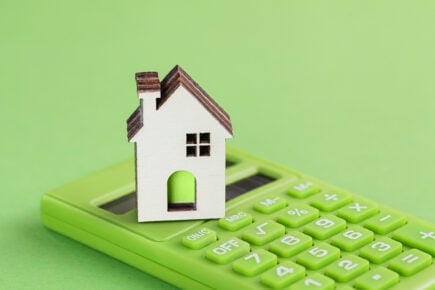Alberta Mortgage Payment Calculator
Use this free calculator to estimate your monthly mortgage payments and the overall cost of your home loan.
Nerdy Tip: Using the Compare function of our Alberta mortgage payment calculator can give you a fuller sense of what your potential mortgage costs might be. You can get a side-by-side view of the different mortgage payments that result from applying different down payment amounts, mortgage rates and amortization lengths.
NerdWallet's Alberta Mortgage Calculator
Mortgage Details
Location Details
Location Details
Mortgage Summary
Estimated Payment
The following items show your expected payment schedule over the full amortization period.
$2,763
Monthly Payment
Mortgage details
Amortization Schedule
Balance remaining in undefined
Payments Breakdown
Year | Total Paid | Principal Paid | Interest Paid | Balance | |
|---|---|---|---|---|---|
| 2024 | $33,151.48 | $9,866.97 | $23,284.52 | $465,133.03 | |
| 2025 | $33,151.48 | $10,366.48 | $22,785.00 | $454,766.55 | |
| 2026 | $33,151.48 | $10,891.29 | $22,260.20 | $443,875.26 | |
| 2027 | $33,151.48 | $11,442.66 | $21,708.83 | $432,432.60 | |
| 2028 | $33,151.48 | $12,021.94 | $21,129.54 | $420,410.66 | |
Term Total | $165,757.42 | $54,589.34 | $111,168.08 | $420,410.66 | |
The line above displays the totals at the end of your mortgage term. At this time, you will renew your mortgage and choose among the rates that are available. The following analysis assumes you will lock in the same rate for the remainder of the amortization period, which may not be possible. | |||||
| 2029 | $33,151.48 | $12,630.55 | $20,520.93 | $407,780.11 | |
| 2030 | $33,151.48 | $13,269.98 | $19,881.51 | $394,510.13 | |
| 2031 | $33,151.48 | $13,941.77 | $19,209.72 | $380,568.36 | |
| 2032 | $33,151.48 | $14,647.57 | $18,503.91 | $365,920.79 | |
| 2033 | $33,151.48 | $15,389.10 | $17,762.38 | $350,531.69 | |
| 2034 | $33,151.48 | $16,168.18 | $16,983.31 | $334,363.51 | |
| 2035 | $33,151.48 | $16,986.69 | $16,164.79 | $317,376.82 | |
| 2036 | $33,151.48 | $17,846.64 | $15,304.84 | $299,530.18 | |
| 2037 | $33,151.48 | $18,750.13 | $14,401.36 | $280,780.05 | |
| 2038 | $33,151.48 | $19,699.35 | $13,452.13 | $261,080.70 | |
| 2039 | $33,151.48 | $20,696.63 | $12,454.85 | $240,384.06 | |
| 2040 | $33,151.48 | $21,744.40 | $11,407.08 | $218,639.66 | |
| 2041 | $33,151.48 | $22,845.21 | $10,306.27 | $195,794.45 | |
| 2042 | $33,151.48 | $24,001.75 | $9,149.73 | $171,792.70 | |
| 2043 | $33,151.48 | $25,216.84 | $7,934.65 | $146,575.86 | |
| 2044 | $33,151.48 | $26,493.44 | $6,658.04 | $120,082.42 | |
| 2045 | $33,151.48 | $27,834.67 | $5,316.81 | $92,247.75 | |
| 2046 | $33,151.48 | $29,243.80 | $3,907.68 | $63,003.95 | |
| 2047 | $33,151.48 | $30,724.27 | $2,427.22 | $32,279.68 | |
| 2048 | $33,151.48 | $32,279.68 | $871.80 | $0.00 | |
Balance remaining in undefined
Payments Breakdown
Year | Total Paid | Principal Paid | Interest Paid | Balance | |
|---|---|---|---|---|---|
| 2024 | $33,151.48 | $9,866.97 | $23,284.52 | $465,133.03 | |
| 2025 | $33,151.48 | $10,366.48 | $22,785.00 | $454,766.55 | |
| 2026 | $33,151.48 | $10,891.29 | $22,260.20 | $443,875.26 | |
| 2027 | $33,151.48 | $11,442.66 | $21,708.83 | $432,432.60 | |
| 2028 | $33,151.48 | $12,021.94 | $21,129.54 | $420,410.66 | |
Term Total | $165,757.42 | $54,589.34 | $111,168.08 | $420,410.66 | |
The line above displays the totals at the end of your mortgage term. At this time, you will renew your mortgage and choose among the rates that are available. The following analysis assumes you will lock in the same rate for the remainder of the amortization period, which may not be possible. | |||||
| 2029 | $33,151.48 | $12,630.55 | $20,520.93 | $407,780.11 | |
| 2030 | $33,151.48 | $13,269.98 | $19,881.51 | $394,510.13 | |
| 2031 | $33,151.48 | $13,941.77 | $19,209.72 | $380,568.36 | |
| 2032 | $33,151.48 | $14,647.57 | $18,503.91 | $365,920.79 | |
| 2033 | $33,151.48 | $15,389.10 | $17,762.38 | $350,531.69 | |
| 2034 | $33,151.48 | $16,168.18 | $16,983.31 | $334,363.51 | |
| 2035 | $33,151.48 | $16,986.69 | $16,164.79 | $317,376.82 | |
| 2036 | $33,151.48 | $17,846.64 | $15,304.84 | $299,530.18 | |
| 2037 | $33,151.48 | $18,750.13 | $14,401.36 | $280,780.05 | |
| 2038 | $33,151.48 | $19,699.35 | $13,452.13 | $261,080.70 | |
| 2039 | $33,151.48 | $20,696.63 | $12,454.85 | $240,384.06 | |
| 2040 | $33,151.48 | $21,744.40 | $11,407.08 | $218,639.66 | |
| 2041 | $33,151.48 | $22,845.21 | $10,306.27 | $195,794.45 | |
| 2042 | $33,151.48 | $24,001.75 | $9,149.73 | $171,792.70 | |
| 2043 | $33,151.48 | $25,216.84 | $7,934.65 | $146,575.86 | |
| 2044 | $33,151.48 | $26,493.44 | $6,658.04 | $120,082.42 | |
| 2045 | $33,151.48 | $27,834.67 | $5,316.81 | $92,247.75 | |
| 2046 | $33,151.48 | $29,243.80 | $3,907.68 | $63,003.95 | |
| 2047 | $33,151.48 | $30,724.27 | $2,427.22 | $32,279.68 | |
| 2048 | $33,151.48 | $32,279.68 | $871.80 | $0.00 | |
Even if you’re not ready to purchase a home in Alberta tomorrow, a mortgage payment calculator is a powerful learning tool that can help you:
- Compare how different interest rates affect mortgage costs.
- Understand the positive impact of a larger down payment.
- Choose an amortization period and payment frequency that best aligns with your budget and home ownership goals.
- Decide which mortgage term you’d be most comfortable with.
- Get a sense of how much house you can afford before viewing properties or applying for a mortgage.
Other mortgage calculators to inform your home buying decision
Average home prices in Alberta
The average residential home price in Alberta was $509,468 in February, according to the Alberta Real Estate Association — a gain of 5.7% since February 2024. Detached homes cost $603,554 on average, and apartments cost $295,501 on average. The average residential price in specific markets includes:
- Calgary: $612,897.
- Edmonton: $419,347.
- Lethbridge: $402,643.
Mortgage payment terminology you’ll need to know
Amortization is the projected time you’ll need to pay off your mortgage. Most borrowers with down payments of less than 20% can’t choose amortization periods longer than 25 years under Canada’s current lending guidelines. First-time home buyers and anyone purchasing new construction also have the option of 30-year amortizations.
Your mortgage term is how long the contract with your current mortgage lender lasts. Five-year terms are the most common, but terms between one and 10 years are also frequently available. You’ll have to renew your mortgage once your term expires, possibly at a different interest rate or with a different lender.
A down payment is the amount of cash you pay upfront for the house (your mortgage covers the difference). For example, if you buy a house for $400,000, you might choose to make a down payment of 20%, or $80,000. You’d need to take out a mortgage for the remaining amount — $320,000.
The size of your down payment can vary, but it must meet minimums based on the price of your home.
| Purchase price | Minimum down payment required |
|---|---|
| Less than $500,000 | 5% of the purchase price |
| $500,000 to $1,499,999 | 5% of the purchase price for the first $500,000; 10% for the portion above $500,000 |
| $1.5 million or more | 20% of the purchase price |
Variable mortgage rates vs. fixed mortgage rates
With a variable-rate mortgage, your interest rate rises and falls with your lender’s prime rate. If you choose a variable-rate mortgage with fixed payments, the monthly payment stays the same even if interest rates increase or decrease, but the amount going toward the principal adjusts. If rates rise, for example, more of the payment will go toward covering interest, and you’ll pay down the principal more slowly.
With a fixed-rate mortgage, the principal and interest portion of your monthly payments will remain the same for the duration of your mortgage term, regardless of what happens with your lender’s prime rate.
Payment frequency
The more frequently you make your mortgage payments, the faster you’ll pay off your mortgage. Mortgage payment frequencies typically include:
- Monthly (12 payments per year).
- Semi-monthly (two payments per month; 24 payments per year).
- Bi-weekly (one payment every 14 days; 26 payments per year).
- Weekly (one payment every 7 days; 52 payments per year).
4 ways to reduce your monthly Alberta mortgage payment
1. Look for a lower interest rate
When it’s time to renew your mortgage, you may have the option to negotiate a lower mortgage interest rate. Any reduction can help; a mortgage with a 4.5% interest rate might not appear much better than a 4.65% rate, for example, but shaving even a few percentage points off can save you thousands of dollars over the course of your mortgage.
2. Make a bigger down payment
Reduce the amount you need to finance with a mortgage by increasing your down payment (though, we get it — that isn’t always an option). A smaller loan leads to lower monthly payments and paying less in interest overall. In some cases, a larger down payment can also help you secure a lower interest rate from your lender.
3. Choose a longer amortization period
Spreading your mortgage out over a longer amortization period results in smaller monthly payments, though the total amount you’ll pay in interest will be higher.
4. Refinance
Refinancing your home loan can also reduce your monthly mortgage payment, especially if the rate you can get today is lower than when you started your mortgage.
If you’ve owned your home for a while, have stayed on top of your mortgage payments and have good credit overall, you’ll put yourself in the best position for the lowest rates.
When you refinance, you essentially begin a new mortgage. That gives you an opportunity to negotiate a lower interest rate and a new payment schedule, both of which can help lower your monthly obligations.
There can be costs to refinancing before your current mortgage is up, however. Review your current agreement to see what limitations you might face — those costs can sometimes outweigh any savings a lower rate would bring.
Frequently asked questions about Alberta mortgage payments
Your monthly mortgage payment will depend heavily on your amortization period and the interest rate offered by your lender. Say you have a $250,000 mortgage, which could buy a $312,500 home with a 20% down payment ($62,500):
- With an interest rate of 4% and an amortization period of 25 years, the monthly payment would be about $1,315. Shorten the amortization period to 20 years, and the monthly payment would be $1,511.
- With an interest rate of 6% and the same 25-year amortization period, that loan would cost almost $1,600 monthly. Repay over 20 years, and the monthly payment would be $1,780.
Lenders don’t just look at your salary in isolation — instead, they consider how much stress a mortgage payment could be. For example, a person with monthly student loan payments could very well be approved for a lower maximum loan amount than an otherwise identical applicant without a monthly debt payment.
More specifically, lenders look at two debt service ratios:
- Gross debt service (GDS) ratio = The percent of your pre-tax household income going towards housing costs, which include mortgage payments, utilities and property taxes. Your GDS ratio should not exceed 39% of your pre-tax household income.
- Total debt service (TDS) ratio = Your GDS plus any other debts. Your TDS ratio should not be more than 44% of your pre-tax household income.
DIVE EVEN DEEPER

The Best Mortgage Rates in Alberta
Compare Alberta mortgage rates from Canada’s top lenders and brokers in minutes. Easily find the best mortgage rate for your needs.

5-Year Fixed Mortgage Rates
Compare customized 5-year fixed mortgage rates from Canada’s best lenders and brokers for free. Find the lowest mortgage rate and apply for the home loan that best fits your needs.

Fixed vs Variable Mortgage Rate: Which Is Better For You?
With a fixed-rate mortgage, your interest rate and payments won’t change during your mortgage term. But they might if you opt for a variable-rate mortgage.
